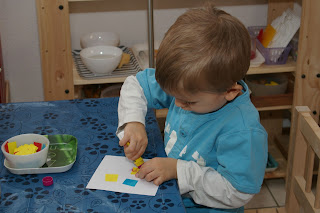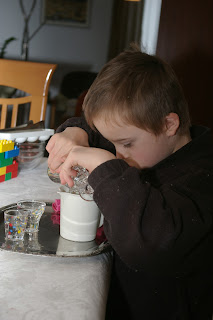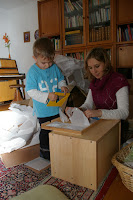TIMES SENSITIVE: A PROGRAMMING "PSYCHIC
The very young child is not simply an" absorbent mind . His mental activity does not only record the phenomena. The observation of its development shows a particular activity that allows him to assimilate the events and the order of a particularly clever way. It is as if a psychic programming provided him the ability to integrate all these impressions to give them an intelligible form. Maria Montessori observed that during the early years of growth, all children have a succession of periods within their model psychic. Leveraging its experience, she observed that some activities seem to benefit children in some very specific periods. These are sensitive times. These faculties are developed at a particular time and ensure the psychological development of children. The knowledge can serve the development of the child without forcing nature while addressing psychological needs.
The succession of these periods follows a specific direction. Each time preparing the next. All these periods are interconnected and serve the development of a unified person. And development the psyche of the child does not proceed at random. It follows a very specific plan guided by these transitional periods that are deemed "critical" in the psychological vocabulary .
These sensitive periods provide the conquest by the child's psychological. Then acquired the capacity will remain as a "character" of his personality. It is therefore important to identify them. Once past, acquisitions are no longer naturally. The development of the sensitivity remain possible. But it will somehow forcing the program starts ... In the Montessori method is particularly environmentally which will enable the child to respond to these sensitive periods. If growth is not by chance, the proposed activities can not be either. The child must be able to find its food in its environment psychic. Indeed these periods make the child aware of certain things and indifferent to others. When there is a period we can say that it is as if a light had just clarify certain aspects of its environment, leaving the others more or less in the shade. These periods are also found in animal and plant world as shown by the Dutch botanist Hugo de Vries in the early twentieth century.
WHAT ARE THE SENSITIVE PERIODS?
Sensitive periods that we know best in children aged 0-6 years are six in number. They are the pillars of its development. We often see in their final stage (order, language, ..) without identifying what is their peak intensity.
- sensory perception: it begins at birth and continues until age 5. During this sensitive period, the child needs to stimulate all five senses as much as possible. To respond to this impulse, it is important to let the child move and get in touch with his environment.
- sensitivity for language : it starts around the age of three months and lasts until the age of 5 years. First sensitive to sounds of voice, he subsequently distinguished the movements of its mouth speaks. Among the sounds, it distinguishes those who belong to the human family who are foreign.
- sensitivity to the order : the sensitive period is certainly the most important Development child's initial. It occurs during the first year and continues for the second year that it knows its peak and decreases gradually at the age of 3 years. The order of this sensitive period should not be confused with the idea that adults would do it for example promote the comfort and excellence in work. For the child, the order addresses the pressing need to find in its environment of reference points (people and objects) stable allowing it to feel safe. This basic feeling it will develop a harmonious personality. The child in this period, which will see a object moved from its usual place may manifest a form of anxiety or anger. It will also time to put in their place the shoes or dad to align its business . If he reacts strongly when you put in "disorder" because he feels threatened in its security psychic. This sensitive period it will develop its internal order. It gradually acquires consciousness of the place it occupies in its environment. It will then be able to order 3 years after its environment in a more intellectual (eg classifications of animals, plants, etc.). Quite the homogeneous development of its intelligence that lies latent in this particular sensitivity.
- The sensitivity for details David Gettman, in his book Basic Montessori speaks wonderfully based on the character of Sherlock Holmes. " The Sherlock Holmes story highlights two vital components of human intelligence: we must be able to extend our powers of observation to all phenomena as the meaning of a situation is not necessarily in the The most obvious phenomenon, then we must be able to concentrate our intellectual power on specific problems. "Thus, this sensitive period will give the child a special sensitivity to the thousand details that surround it to enable it later to focus later on phenomena that are less visible.
- The sensitivity to movement coordination : it rises about 2 years and a half and lasts up to 4 years. It means that the child will try to submit the movements of his body in the power of his will. It 's try to use one or another of its members to gain control and coordination. At 3 years the child washes his hands sometimes repeatedly not to make them more and cleaner, but to achieve better and better to use soap and water using both hands.
- The sensitivity to social relations: it starts to 2years and a half and lasts until the age of 5 years. It allows the child to acquire the characteristics of its culture to adapt. The child will pay particular attention to responses to their behavior. This period will allow the child to develop friendly behavior to take part in the life of small groups.




























































